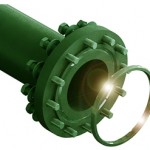Carbon steel

Carbon steel is a metal alloy that is formed as a result of combining iron and carbon.
The American Iron and Steel Institute (AISI) defines carbon steel as follows:
Carbon Steel is considered to be carbon steel when no minimum content is specified or required for chromium, cobalt, columbium [niobium], molybdenum, nickel, titanium, tungsten, vanadium or zirconium, or any other element to be added to obtain a desired alloying effect; when the specified minimum for copper does not exceed 0.40 per cent; or when the maximum content specified for any of the following elements does not exceed the percentages noted: manganese 1.65, silicon 0.60, copper 0.60.
Carbon steel is classified as follows
- Low Carbon Steel or Mild Steel
- Medium Carbon Steel
- High Carbon Steel
- Higher carbon steels
- Ultra-high carbon steel
Carbon steel can be classified, according to various deoxidation practices, as rimmed, capped, semi-killed, or killed steel. Deoxidation practice and the steelmaking process will have an effect on the properties of the steel. However, variations in carbon have the greatest effect on mechanical properties, with increasing carbon content leading to increased hardness and strength. As such, carbon steels are generally categorized according to their carbon content. Generally speaking, carbon steels contain up to 2% total alloying elements and can be subdivided into low-carbon steels, medium-carbon steels, high-carbon steels, and ultrahigh-carbon steels; each of these designations is discussed below.
As a group, carbon steels are by far the most frequently used steels. More than 85% of the steel produced and shipped in the United States is carbon steel.
Definition of Carbon steel
Steel is carbon steel when is doesn’t contain Aluminum, Boron, Chromium, Cobalt, Columbium, Molybdenum, Nickel, Titanium, Tungsten, Vanadium or Zirconium. Copper does not exceed 0.40% or when the maximum content specified does not exceed the percentage noted
- Manganese 1.65%
- Silicon 0.6%
- Copper 0.6%
Carbon steels are different from cast iron as regards the percentage of carbon. Carbon contains 0.10 to 1.5% carbon whereas cast iron possesses from 1.8 to 4.2% carbon.
Steel typically is considered to be carbon steel when the proportions of other trace elements in it do not exceed certain percentages. The maximum percentages typically are 1.65 percent for manganese and 0.6 percent for copper and silicon. The copper percentage must be at least 0.4 percent. Steel that also contains higher or specified quantities of other elements, such as nickel, chromium or vanadium, is called alloy steel.
ASTM A106 Covers seamless carbon steel nominal wall pipe for high-temperature service, suitable for bending flanging and similar forming operations.
Manufacturers add carbon to iron to solidify the structures in it and strengthen the resulting metal. It’s one of the most cost-effective alloying materials, and altering the amount of carbon changes the properties of the steel. Carbon steels can be classified as low-carbon steels, medium-carbon steels, high-carbon steels and ultrahigh-carbon steels.
Steels with very low amounts of carbon, about 0.05 percent to 0.3 percent, are called low-carbon steels and are similar to iron. They are very ductile, which makes them hard to machine. They are used to make flat-rolled sheets or steel strips that are utilized to create ships, wire products, car bodies, domestic appliances, tin plates and more. Low-carbon steels are cheaper, but they cannot be altered by heat treatment, which is why they generally are used for fabrication and paneling purposes.
Carbon steel may also be used in reference to steel which is not stainless steel; in this use carbon steel may include alloy steels.
As the carbon content rises, steel has the ability to become harder and stronger through heat treating, but this also makes it less ductile. Regardless of the heat treatment, a higher carbon content reduces weldability. In carbon steels, the higher carbon content lowers the melting point.
Carbon steel is broken down in to four classes based on carbon content:
Mild and low carbon steel
Mild steel, also called plain-carbon steel, is the most common form of steel because its price is relatively low while it provides material properties that are acceptable for many applications. Low carbon steel contains approximately 0.05–0.15% carbon and mild steel contains 0.16–0.29% carbon; making it malleable and ductile, but it cannot be hardened by heat treatment. Mild steel has a relatively low tensile strength, but it is cheap and malleable; surface hardness can be increased through carburizing.
It is often used when large quantities of steel are needed, for example as structural steel. The density of mild steel is approximately 7.85 g/cm3 (7850 kg/m3 or 0.284 lb/in3) and the Young’s modulus is 210 GPa (30,000,000 psi).
Low carbon steels suffer from yield-point runout where the material has two yield points. The first yield point (or upper yield point) is higher than the second and the yield drops dramatically after the upper yield point. If a low carbon steel is only stressed to some point between the upper and lower yield point then the surface may develop Lüder bands. Low carbon steels contain less carbon than other steels and are easier to cold-form, making them easier to handle.
Medium carbon steel
Approximately 0.30–0.59% carbon content.Balances ductility and strength and has good wear resistance; used for large parts, forging and automotive components.
High carbon steel
Approximately 0.6–0.99% carbon content. Very strong, used for springs and high-strength wires.
Higher carbon steels
Carbon steels which can successfully undergo heat-treatment have a carbon content in the range of 0.30–1.70% by weight.
Ultra-high carbon steel
Approximately 1.0–2.0% carbon content. Steels that can be tempered to great hardness.










